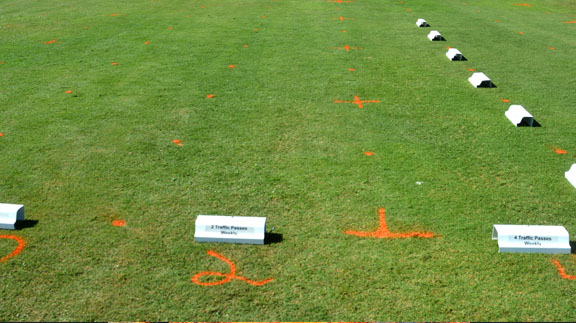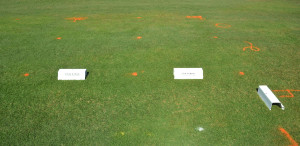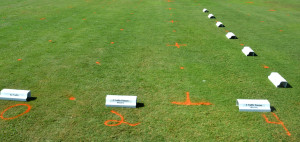Farm & Ranch
[AgriLife Today] Turfgrass researcher works to keep athletic fields green longer

|
By: Kay Ledbetter
Fungicide, nitrogen looked at to reduce wear and tear Writer: Kay Ledbetter, 806-677-5608, [email protected] COLLEGE STATION – Sports fans know as fall sets in and their favorite team heads out on the turf, the bright green grass begins to turn brown from the wear and tear and changing temperatures. 
Nitrogen rate comparisons on turfgrass plots were done by Dr. Ben Wherley, a Texas A&M AgriLife Research turfgrass ecologist.(Texas A&M AgriLife Communications photo by Kay Ledbetter) But a Texas A&M AgriLife Research turfgrass ecologist has completed a study identifying ways to reduce the look of wear and tear from athletic turf traffic. Dr. Ben Wherley, an assistant professor for turfgrass science/ecology with AgriLife Research and the Texas A&M University soil and crop science department in College Station, spent the summer looking at the effects of nitrogen and the fungicide Civitas on foot traffic tolerance on athletic turf. The plots were Tifway Bermuda grass, which is an industry standard for athletic fields in the south, Wherley said. “What we’ve done is traffic these plots with a Brinkman traffic simulator,” he said, adding they did either zero, two or four passes per week through the summer and into the fall. “What we’re trying to do is simulate athletic field traffic that would be equivalent to football.” https://www.youtube.com/watch?v=DNBE4SB6Nqc&feature=youtu.be Past research has shown that two passes per week is equivalent to the amount of stress produced by one NFL football game between the hash marks and the 40-yard line, Wherley said. 
Dr. Ben Wherley, a Texas A&M AgriLife Research turfgrass ecologist, used this Brinkman traffic simulator on his turfgrass plots. (Texas A&M AgriLife Communications photo by Kay Ledbetter) “So looking at these traffic levels of one versus two games a week versus no games a week, what we were trying to determine was the relative effects of nitrogen rate and also a biweekly application of a product known as Civitas, which is labeled as a fungicide but also has been shown to have some other side benefits in terms of various types of stress tolerance.” The application treatment every two weeks included no Civitas, an 8.5 ounces rate of Civitas per thousand square feet and 17 ounces per thousand square feet rate. “So every two weeks through the summer we basically evaluated percent green cover, the amount of green coverage in the plots, also rating the amount of the injury we’re seeing in the plots,” Wherley said. 
Various traffic patterns were compared under treatments of Civitas on turfgrass plots by Dr. Ben Wherley, a Texas A&M AgriLife Research turfgrass ecologist.(Texas A&M AgriLife Communications photo by Kay Ledbetter) “Particularly we were interested as we got into the later fall months when temperatures cooled, daylight or solar radiation was lower and Bermuda grass started going dormant to see whether Civitas could prolong the green cover in the plots,” he said. “Representative of a football field getting into the late fall, we wanted to know if this might be used as an alternative to overseeding because of the benefits of the fungicide combined with pigment in this product.” He said the results showed improvement in green turf cover and color from the Civitas application across all treatments of traffic, “but we had mixed results in terms of improved resistance to or recovery from injury with Civitas.” Wherley said it was also interesting to note that there wasn’t a big difference between the low applications of nitrogen, a quarter pound per growing month, and the high, typically 1 pound per growing month. “This is probably a result of the fact that the soils in our plots have a good amount of inherent organic matter and fertility in them,” he said. “The site is an old dairy farm pasture. So what this tells the turf manager is if you have good levels of soil organic matter, there may not be as high of a nitrogen requirement on your turf.” Wherley said they learned more about the use of Civitas for athletic turf and hopefully through additional testing, will have a good recommendation in the future. -30-
Find more stories, photos, videos and audio at http://today.agrilife.org |
Farm & Ranch
Managing Show Cattle Through The Winter

By Heather Welper
Husband and wife duo, Heather and Calvin Welper, are the Co-Owners and Operators or Two C Livestock, located in Valley View, Texas.
The pair’s operation has a show cattle focus where they raise and sell purebred heifers of all breeds and club calf Hereford steers.
When it comes to show cattle, the Welpers know a thing or two including how to prepare for the cold winter months and the Texas major show season run.
To read more, pick up a copy of the November edition of North Texas Farm & Ranch magazine, available digitally and in print. To subscribe by mail, call 940-872-5922.

Farm & Ranch
Double M Ranch & Rescue

By Hannah Claxton, Editor
As the sun rises each day, so do the dozens of mouths that Meghan McGovern is responsible for getting fed. Rather than the sounds of a rooster crowing, McGovern hears the bellows and bleats of a variety of exotic deer, the chortle of kangaroos, the grunts of water buffaloes, and the chirps of a lemur.
Nestled against the banks of the Red River, the Double M Ranch and Rescue, with its high game fences and deer sprinkling the landscape,s its in stark contrast to the surrounding ranches.
“Having deer is kind of like eating potato chips- you can never actually have just one,” said McGovern with a laugh.
McGovern has several herds to take care of- fallow deer, axis deer, water buffalo, goats, and bison. In smaller numbers, there’s also a few kangaroos, a lemur, a potbelly pig, a pair of zebras, a watusi, and a few horses.
To read more, pick up a copy of the November edition of North Texas Farm & Ranch magazine, available digitally and in print. To subscribe by mail, call 940-872-5922.

Farm & Ranch
Acorn Toxicity

By Barry Whitworth, DVM, MPH
With the prolonged drought, most pastures in Oklahoma end up in poor condition. With the lack of available forage, animals may go in search of alternative foods.
If oak trees are in the pastures, acorns may be a favorite meal for some livestock in the fall. This may result in oak poisoning.
Oak leaves, twigs, buds, and acorns may be toxic to some animals when consumed.
To read more, pick up a copy of the November edition of North Texas Farm & Ranch magazine, available digitally and in print. To subscribe by mail, call 940-872-5922.

-

 Country Lifestyles2 years ago
Country Lifestyles2 years agoScott & Stacey Schumacher: A Growth Mindset
-

 Country Lifestyles8 years ago
Country Lifestyles8 years agoStyle Your Profile – What your style cowboy hat says about you and new trends in 2017
-

 HOME8 years ago
HOME8 years agoGrazing North Texas – Wilman Lovegrass
-

 Outdoor10 years ago
Outdoor10 years agoButtercup or Primrose?
-

 Country Lifestyles5 years ago
Country Lifestyles5 years agoAmber Crawford, Breakaway Roper
-

 Equine1 year ago
Equine1 year agoThe Will to Win
-

 Country Lifestyles9 years ago
Country Lifestyles9 years agoJune 2016 Profile – The man behind the mic: Bob Tallman
-

 Country Lifestyles8 years ago
Country Lifestyles8 years agoDecember 2016 Profile, Rusty Riddle – The Riddle Way




